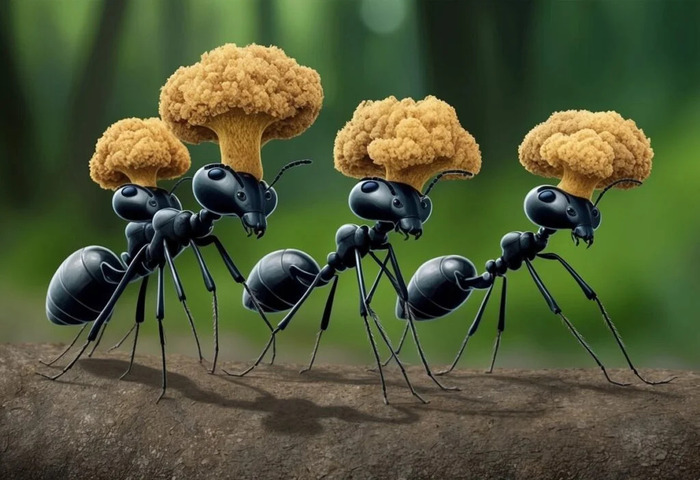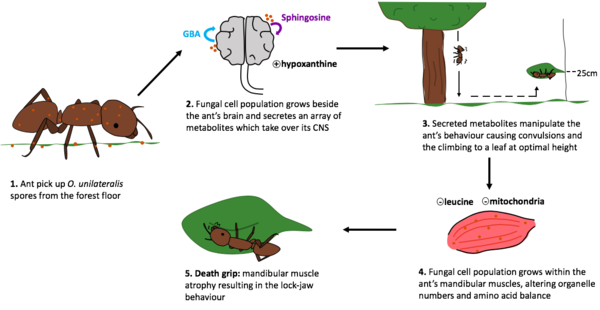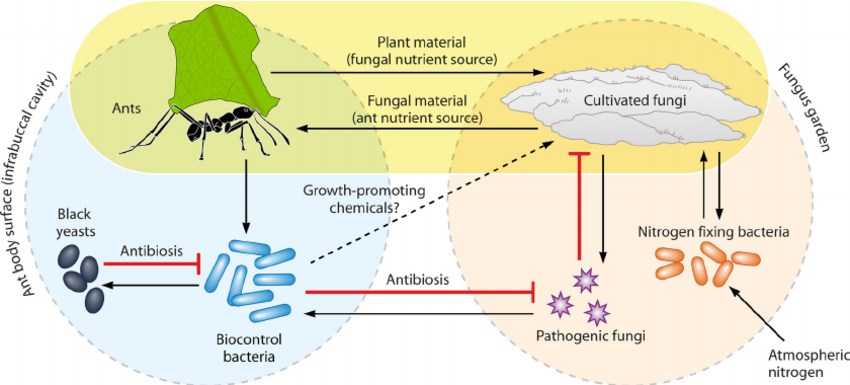When you think of symbiotic relationships in nature, you probably imagine cooperation between two species, like bees and flowers. However, in the world of ants and brain-eating fungi, it’s a different story entirely. The ant and the brain eating fungus symbiotic relationship is one of nature’s most chilling yet intriguing examples of parasitism. In this article, we’ll dive into the world of Ophiocordyceps unilateralis, the fungus responsible for hijacking ants’ brains and how this parasitic relationship unfolds.

The brain-eating fungus we’re talking about is Ophiocordyceps unilateralis, a parasitic fungus that targets ants, particularly fire ants. Unlike typical symbiotic relationships, where both species benefit, this relationship is a one-sided affair where the fungus takes complete control of the ant’s body and mind. Once infected, the ant becomes a "zombie," mindlessly following the fungus’s orders until it ultimately dies. This parasitism is an extreme example of how some fungi can manipulate insect behavior to their advantage.
Ophiocordyceps is a genus of parasitic fungi, and Ophiocordyceps unilateralis is particularly notorious for infecting ants. The fungus infects the ant when it comes into contact with fungal spores, which attach to the ant’s exoskeleton and infiltrate its body. Once inside, the fungus spreads through the ant’s body and gradually takes control of its nervous system, steering it away from its colony and toward a high plant or tree.

When the fungus infects the ant, it releases chemicals that hijack the ant’s brain, taking control of its movement. The ant, now a “zombie,” is compelled to climb vegetation and attach itself with its mandibles. This behavior is known as the "death grip," where the ant bites onto a plant or tree and remains there, stuck until it dies. After the ant dies, the fungus produces a stalk-like structure that emerges from the back of the ant’s head. This structure releases spores, which fall to the ground below and await another ant to pick them up.
The life cycle of Ophiocordyceps is one of the most gruesome and fascinating processes in nature. It begins when the fungus’s spores come into contact with an ant. The spores attach to the ant’s body and begin to grow, penetrating the exoskeleton and moving inside the body. Over time, the fungus spreads through the ant, controlling its nervous system.
Once the fungus has sufficiently taken control, it forces the ant to climb vegetation. The ant attaches to the plant with its mandibles, remaining there until death. Once the ant is dead, the fungus produces a stalk that extends from the back of the ant’s head, releasing new spores that fall to the forest floor. These spores are then picked up by other ants, starting the cycle over again.
You’ve probably heard of zombie ants, and yes, it’s just as creepy as it sounds. Once an ant is infected by Ophiocordyceps unilateralis, its body is taken over by the fungus, which controls the ant’s actions. This “zombie” ant then leaves its colony and climbs to a high spot where it remains attached, waiting for death to arrive. This transformation from a normal ant to a mind-controlled zombie is one of the most well-documented examples of parasitism in nature.
While this may sound like something out of a horror movie, it is, in fact, a highly evolved survival strategy for the fungus. The ant serves as the perfect host for the fungus’s spores to be spread far and wide, ensuring the fungus’s reproductive success.
The ant and the brain eating fungus symbiotic relationship isn’t mutual—it’s purely parasitic. The ant plays an important role in the fungus’s reproductive cycle. Once the fungus has controlled the ant, the insect becomes an effective vehicle for the fungus to spread its spores. The fungus’s reproductive success depends on the ant’s behavior, as the ant unknowingly climbs a plant and attaches itself with its mandibles, allowing the fungus to thrive and reproduce.
In this way, the fungus ensures that its spores are dropped at the optimal location, where they will have the highest chance of being picked up by other ants. The process is a stark reminder of how nature uses parasitism to maintain balance in ecosystems.
 (Role of BFIs in ant-fungus mutualism. Nutrient flows and inhibitory interactions between organisms are indicated by arrows and blocked arrowheads, respectively. Major inputs of carbon (plant biomass) and nitrogen (plant biomass and nitrogen-fixing bacteria) provide the raw materials to support the web of interactions and are indicated with bold arrows. Ants transfer pathogenic Escovopsis fungi to their infrabuccal pocket during sanitization of the fungus garden. )
(Role of BFIs in ant-fungus mutualism. Nutrient flows and inhibitory interactions between organisms are indicated by arrows and blocked arrowheads, respectively. Major inputs of carbon (plant biomass) and nitrogen (plant biomass and nitrogen-fixing bacteria) provide the raw materials to support the web of interactions and are indicated with bold arrows. Ants transfer pathogenic Escovopsis fungi to their infrabuccal pocket during sanitization of the fungus garden. )
While the ant and the brain eating fungus symbiotic relationship may seem horrifying, it plays a role in regulating ant populations. The fungus keeps the ant population in check by infecting and killing off large numbers of ants. This helps prevent ant colonies from becoming too large, which could have detrimental effects on the ecosystem.
In fact, parasitic fungi like Ophiocordyceps help maintain biodiversity by controlling the population of certain species. Without the presence of such parasites, certain species might become overpopulated and threaten other organisms in the ecosystem.
While Ophiocordyceps unilateralis is the most famous example of a brain-eating fungus, it’s not the only fungus that manipulates insect behavior. Cordyceps fungi are a diverse group that parasitize many other insects, including caterpillars, beetles, and even spiders. These fungi work similarly by taking over their host’s brain and body, turning them into zombies that help the fungus complete its life cycle.
The ability of fungi to manipulate insect behavior is a testament to the incredible ways that nature has evolved to ensure survival, whether through parasitism or mutualism.
The ant and the brain eating fungus symbiotic relationship is an example of parasitism, rather than mutualism. The ant does not benefit in any way from the fungus’s presence, while the fungus gains everything it needs to reproduce and spread its spores. In fact, the term “symbiosis” usually refers to a relationship where both species benefit, but in the case of the brain-eating fungus, the relationship is entirely one-sided. The fungus’s manipulation of the ant’s behavior is a textbook example of how parasitism works in nature.
When ants are infected by Ophiocordyceps, they begin to exhibit strange behaviors. The fungus takes control of their brain, directing them to leave their colony and climb high into vegetation. Once the ant reaches the ideal spot, it bites down on a leaf or twig and remains there until it dies. The fungus grows from the back of the ant’s head, releasing spores that fall to the ground below, where they can infect other ants.
What is the brain-eating fungus that affects ants?
The brain-eating fungus is Ophiocordyceps unilateralis, a parasitic fungus that infects ants, takes control of their brain, and forces them to climb vegetation before eventually killing them.
How does the fungus control the ant’s behavior?
The fungus releases chemicals that hijack the ant’s brain, causing it to climb plants and bite onto leaves or twigs, where it will stay until it dies.
What role do ants play in the life cycle of the fungus?
Ants serve as the perfect hosts for the fungus, helping to spread its spores to other ants. The fungus uses the ant’s body as a vehicle to transport itself to an optimal location for reproduction.
The ant and the brain eating fungus symbiotic relationship is a strange, unsettling, and yet awe-inspiring example of nature’s power. Through parasitism, Ophiocordyceps unilateralis has evolved to manipulate ants in such a way that it ensures its own survival and reproductive success. Whether you find it horrifying or fascinating, it’s a powerful reminder of the intricate relationships that shape life on Earth.
animal tags: ant brain-eating-fungus
We created this article in conjunction with AI technology, then made sure it was fact-checked and edited by a Animals Top editor.